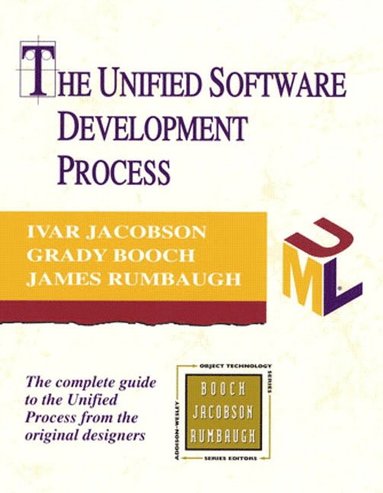
- Format
- Inbunden (Hardback)
- Språk
- Engelska
- Antal sidor
- 512
- Utgivningsdatum
- 1999-02-01
- Upplaga
- 1
- Förlag
- Addison Wesley
- Medarbetare
- Booch, Grady / Rumbaugh, James
- Illustratör/Fotograf
- TabUÜbers Mit Abb
- Illustrationer
- Mit Abb., Tab. u. Übers.
- Dimensioner
- 240 x 190 x 27 mm
- Vikt
- Antal komponenter
- 1
- ISBN
- 9780201571691
- 899 g
The Unified Software Development Process
The complete guide to the Unified Process from the original designers.
Slutsåld
Kundrecensioner
Fler böcker av Ivar Jacobson
-
Essentials of Modern Software Engineering
Ivar Jacobson, Harold "Bud" Lawson, Pan-Wei Ng, Paul E McMahon, Michael Goedicke
-
Essence of Software Engineering, The
Ivar Jacobson, Pan-Wei Ng, Paul E McMahon, Ian Spence, Svante Lidman
SEMAT (Software Engineering Methods and Theory) is an international initiative designed to identify a common ground, or universal standard, for software engineering. It is supported by some of the most distinguished contributors to the field. Crea...
Övrig information
Ivar Jacobson is one of the fathers of components and component architecture, use cases, modern business engineering, the Unified Modeling Language, and the Rational Unified Profess. He is the principal author of five best-selling books on these methods and technologies, in addition to being the coauthor of the two leading books on the Unified Modeling Language. Ivar is an executive technical consultant to IBM Rational and founder of Ivar Jacobson International. He is also currently focusing his efforts on his new software company, Jaczone AB, where he and his daughter and cofounder, Agneta Jacobson, develop intelligent agents for software development.Grady Booch, is the Chief Scientist at Rational Software Corporation and developer of the Booch Method of object-oriented analysis and design. He is also co-developer of the Unified Modeling Language (UML). Widely recognized for these and many contributions in the field, he is a popular speaker at technology conferences around the world. Booch has twice received Software Development magazine's coveted Jolt-Cola Product Excellence Award for his seminal text,Object-Oriented Analysis and Design with Applications. Dr. James Rumbaugh is one of the leading object-oriented methodologists. He is the chief developer of the Object Modeling Technique (OMT) and the lead author of the best-selling book Object-Oriented Modeling and Design. Before joining Rational Software Corporation in October 1994, he worked for more than 25 years at General Electric Research and Development Center in Schenectady, New York.He has been working on object-oriented methodology and tools for many years. He developed the DSM object-oriented programming language, the state tree model of control, the OMT object modeling notation, and the Object Modeling Tool graphic editor. The foundations for the OMT notation were developed more than 10 years ago with Mary Loomis and Ashwin Shah of Calma Corporation. The OMT methodology was developed at GE R D Center with coauthors Mike Blaha, Bill Premerlani, Fred Eddy, and Bill Lorensen.Dr. Rumbaugh received his Ph.D. in computer science from MIT. During his Ph.D. research under Professor Jack Dennis, Dr. Rumbaugh was one of the inventors of data flow computer architecture. His career has dealt with semantics of computation, tools for programming productivity, and applications using complex algorithms and data structures. Dr. Rumbaugh has published journal articles on his work and has spoken at leading object-oriented conferences. He writes a regular column for the Journal of Object-Oriented Programming.Dr. Rumbaugh is the lead author of the recent best-selling book Object-Oriented Modeling and Design, published by Prentice Hall. His latest book, OMT Insights: Perspectives on Modeling from the Journal of Object-Oriented Programming, was released in October 1996. He and his colleagues developed the OMT methodology described in the book based on real-world applications at GE, and they have worked to extend the original methodology. He has taught courses based on the methodology to different audiences around the world, ranging from one-hour seminars to intensive several-day training courses.He has a B.S. in physics from MIT, an M.S. in astronomy from Caltech, and a Ph.D. in computer science from MIT.During his career at GE, he worked on a variety of problems, including the design of one of the first time-sharing operating systems, early work in interactive graphics, algorithms for computed tomography, use of parallel machines for fast image generation, VLSI chip design, and finally, object-oriented technology.Jim developed OMTool, an interactive graphical editor for manipulation of object model diagrams. The editor is commercially available. In addition, he led a five-year programming effort producing production-quality so
Innehållsförteckning
Preface.
I. THE UNIFIED SOFTWARE DEVELOPMENT PROCESS.
1. The Unified Process: Use-Case Driven, Architecture-Centric, Iterative, and Incremental.The Unified Process in a Nutshell.The Unified Process Is Use-Case Driven.The Unified Process Is Architecture-Centric.The Unified Process Is Iterative and Incremental.The Life of the Unified Process.The Product.Phases within a Cycle.An Integrated Process.2. The Four Ps: People, Project, Product, and Process in Software Development.
People Are Crucial.Development Processes Affect People.Roles Will Change.Turning Resources into Workers.Projects Make the Product.Product Is More Than Code.What Is a Software System?Artifacts.A System Has a Collection of Models.What Is a Model?Each Model Is a Self-Contained View of the System.Inside a Model.Relationships between Models.Process Directs Projects.Process: A Template.Related Activities Make Up Workflows.Specializing Process.Merits of Process.Tools Are Integral to Process.Tools Impact Process.Process Drives Tools.Balance Process and Tools.Visual Modeling Supports UML.Tools Support the Whole Life Cycle.References.3. A Use-Case-Driven Process.
Use-Case-Driven Development in Brief.Why Use Cases?To Capture the Value Adding Requirements.To Drive the Process.To Devise the Architecture and More...Capturing the Use Cases.The Use-Case Model Represents the Functional Requirements.Actors Are the Environment of the System.Use Cases Specify the System.Analysis, Design, and Implementation to Realize the Use Cases.Creating the Analysis Model from the Use Cases.Each Class Must Fulfill All Its Collaboration Roles.Creating the Design Model from the Analysis Model.Subsystems Group Classes.Creating the Implementation Model from the Design Model.Testing the Use Cases.Summing Up.References.4. An Architecture-Centric Process
Architecture in Brief.Why We Need Architecture.Understanding the System.Organizing Development.Fostering Reuse.Evolving the System.Use Cases and Architecture.The Steps to an Architecture.The Architecture Baseline Is a Small, Skinny System.Using Architectur...
Du kanske gillar
-
Nexus
Yuval Noah Harari
Häftad -
Careless People
Sarah Wynn-Williams
Inbunden
